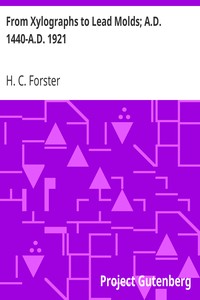From Xylographs to Lead Molds; A.D. 1440-A.D. 1921 by H. C. Forster
"From Xylographs to Lead Molds; A.D. 1440-A.D. 1921" by H. C. Forster is a historical account written in the early 20th century that explores the evolution of printing technology from its inception to the early 20th century. The book presents an insightful examination of the significant developments in printing methods, specifically focusing on the transition from wooden block printing (xylography) to the use of lead molds and electrotyping. This work highlights the
pivotal role of printing in the spread of knowledge and culture during the Renaissance and beyond. The narrative unfolds as Forster delves into the milestones of printing history, detailing key figures such as Johannes Gutenberg and Lourens Janszoon Coster, and the controversies surrounding the invention of movable type. It elucidates the technological advancements that shaped the craft, including the introduction of various casting methods, stereotyping, and electrotyping processes, which revolutionized the printing industry. The author also discusses practical implications for advertisers and printers in utilizing these methods to improve print quality and efficiency, ultimately illustrating how these innovations transformed the accessibility of printed materials for the masses. (This is an automatically generated summary.)
Read or download for free
| How to read | Url | Size | |||
|---|---|---|---|---|---|
| Read now! | https://www.gutenberg.org/ebooks/33497.html.images | 124 kB | |||
| EPUB3 (E-readers incl. Send-to-Kindle) | https://www.gutenberg.org/ebooks/33497.epub3.images | 717 kB | |||
| EPUB (older E-readers) | https://www.gutenberg.org/ebooks/33497.epub.images | 715 kB | |||
| EPUB (no images, older E-readers) | https://www.gutenberg.org/ebooks/33497.epub.noimages | 238 kB | |||
| Kindle | https://www.gutenberg.org/ebooks/33497.kf8.images | 554 kB | |||
| older Kindles | https://www.gutenberg.org/ebooks/33497.kindle.images | 465 kB | |||
| Plain Text UTF-8 | https://www.gutenberg.org/ebooks/33497.txt.utf-8 | 97 kB | |||
| Download HTML (zip) | https://www.gutenberg.org/cache/epub/33497/pg33497-h.zip | 606 kB | |||
| There may be more files related to this item. | |||||
Similar Books
About this eBook
| Author | Forster, H. C. |
|---|---|
| LoC No. | 22026053 |
| Title | From Xylographs to Lead Molds; A.D. 1440-A.D. 1921 |
| Credits | E-text prepared by Barbara Tozier, Bill Tozier, and the Project Gutenberg Online Distributed Proofreading Team (http://www.pgdp.net) |
| Reading Level | Reading ease score: 58.6 (10th to 12th grade). Somewhat difficult to read. |
| Language | English |
| LoC Class | Z: Bibliography, Library science |
| Subject | Printing -- History |
| Subject | Electrotyping |
| Category | Text |
| EBook-No. | 33497 |
| Release Date | Aug 24, 2010 |
| Most Recently Updated | Jan 29, 2021 |
| Copyright Status | Public domain in the USA. |
| Downloads | 286 downloads in the last 30 days. |
| Project Gutenberg eBooks are always free! | |

